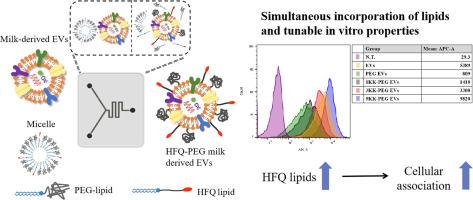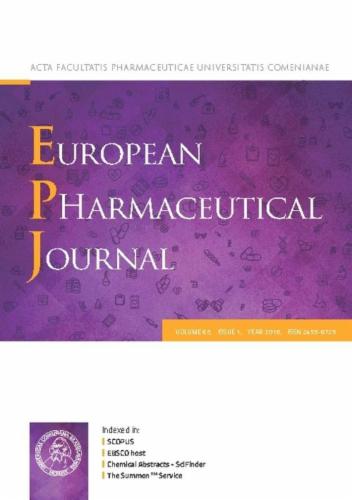Microfluidic post-insertion of polyethylene glycol lipids and KK or RGD high functionality and quality lipids in milk-derived extracellular vesicles
IF 4.3
3区 医学
Q1 PHARMACOLOGY & PHARMACY
引用次数: 0
Abstract
To achieve the desired delivery effect, extracellular vesicles (EVs) must bypass rapid clearance from circulation and exhibit affinity for target cells; however, it is difficult to simultaneously incorporate two materials into EVs. Post-insertion is a general modification method that can be performed by simply mixing different solutions. Previously, we have developed a microfluidic post-insertion method that supported fast and upscaled modification of EVs using KK-modified high-functionality and -quality (HFQ) lipids. Here, we used microfluidic post-insertion to achieve simultaneous incorporation of polyethylene glycol (PEG) lipids and KK or RGD-modified HFQ lipids into milk-derived EVs to avoid uptake from the reticuloendothelial system and increase the uptake into target cells. PEG lipid and HFQ lipids were formulated to produce micelles and subsequently mixed with EV solution using a microfluidic device. Compared to bulk mixing, microfluidic post-insertion showed higher cellular association. Altered cellular association capacities and endocytic pathways indicated simultaneous incorporation. The cellular association of modified EVs can be adjusted by altering the ratio of (EK)4-KK in micelles with slight changes in physicochemical properties. Furthermore, microfluidic post-insertion is also suitable for (SG)5-RGD, which is insoluble in phosphate-buffered saline (PBS). Our results may be valuable for the development and manufacture of functional EVs as drug delivery systems for clinical applications.

用微流体技术将聚乙二醇脂质和 KK 或 RGD 高功能优质脂质后植入源于牛奶的细胞外囊泡。
为了达到理想的递送效果,细胞外囊泡(EVs)必须绕过血液循环的快速清除,并显示出对靶细胞的亲和力;然而,很难同时将两种材料加入到 EVs 中。后植入是一种通用的改性方法,只需混合不同的溶液即可实现。此前,我们开发了一种微流控插入后方法,支持使用 KK 修饰的高功能和高质量(HFQ)脂质快速、大规模地修饰 EVs。在这里,我们利用微流体后植入法将聚乙二醇(PEG)脂质和KK或RGD修饰的HFQ脂质同时加入牛奶衍生的EVs中,以避免从网状内皮系统摄取,并增加靶细胞的摄取。将 PEG 脂质和 HFQ 脂质配制成胶束,然后使用微流控装置与 EV 溶液混合。与散装混合相比,微流控插入后的细胞结合率更高。细胞结合能力和内吞途径的改变表明,EVs与细胞同时结合。通过改变(EK)4-KK 在胶束中的比例,可以调整改性 EVs 的细胞结合率,而理化性质则略有变化。此外,微流体后植入也适用于不溶于磷酸盐缓冲盐水(PBS)的(SG)5-RGD。我们的研究结果可能对开发和制造用于临床应用的功能性 EVs 药物递送系统很有价值。
本文章由计算机程序翻译,如有差异,请以英文原文为准。
求助全文
约1分钟内获得全文
求助全文
来源期刊
CiteScore
9.60
自引率
2.20%
发文量
248
审稿时长
50 days
期刊介绍:
The journal publishes research articles, review articles and scientific commentaries on all aspects of the pharmaceutical sciences with emphasis on conceptual novelty and scientific quality. The Editors welcome articles in this multidisciplinary field, with a focus on topics relevant for drug discovery and development.
More specifically, the Journal publishes reports on medicinal chemistry, pharmacology, drug absorption and metabolism, pharmacokinetics and pharmacodynamics, pharmaceutical and biomedical analysis, drug delivery (including gene delivery), drug targeting, pharmaceutical technology, pharmaceutical biotechnology and clinical drug evaluation. The journal will typically not give priority to manuscripts focusing primarily on organic synthesis, natural products, adaptation of analytical approaches, or discussions pertaining to drug policy making.
Scientific commentaries and review articles are generally by invitation only or by consent of the Editors. Proceedings of scientific meetings may be published as special issues or supplements to the Journal.

 求助内容:
求助内容: 应助结果提醒方式:
应助结果提醒方式:


